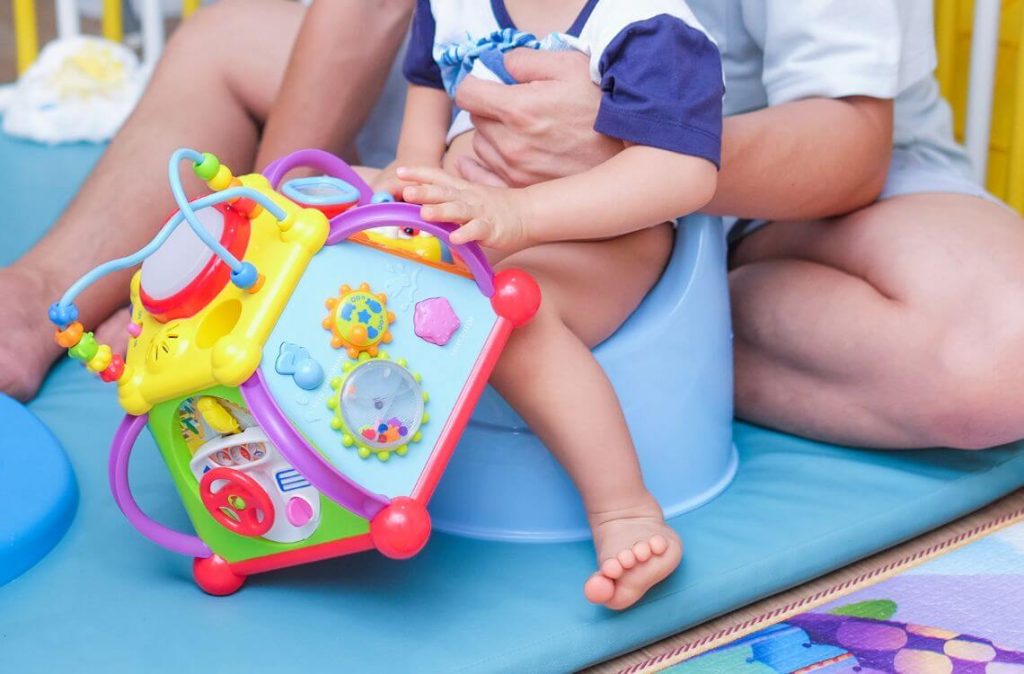Potty training is a long and tedious process. It can take a lot of effort to get through this period, and not everyone has the time for it.
As parents it is your responsibility to care for your child no matter what the circumstances are.
So learn how to potty train your kids effectively, even on a tight schedule.
Potty Routine
Having a routine is a simple way to introduce the potty to your child.
The best way to do this is sit them on it every 15 to 20 minutes whether or not they need to use it.
This routine will encourage them to notice the urge to relieve themselves. Once they are able to recognise this urge, they can give you signals as to when they need to use the potty.
These signals may be verbal, they might point or even try to use the potty on their own.
You will learn how to read your toddlers indications over time.
Once you have stablished this routine with your baby, use it to make them comfortable with the idea of using the potty even if they don’t go at first. Explain what it is and how to use it.
Remember, try not to let them sit on the potty for more than five minutes at a time.
It shouldn’t be confused for a chair and if they spend too long in it they may get that misconception. Short and frequent visits are the way to go.
Following Examples
Many children are hesitant to do something unless they see others doing it first.
Being the only one in new situation can be unnerving for anyone.
The first way to show them an example is with a toy. Mime out a situation in which their favourite toy needs to use the potty.
Make the example look easy and comfortable, and it will usually work for young toddlers.
Another method requires no effort on your part, but only works if your toddler goes to a kindergarten; or any other childcare centre.
Watching others kids use the potty or toilet can be a great motivator for them to progress.
This is a truly effective tool because no one wants to get left behind.
This way, your child will not feel forced but they will still take the initiative to try our the potty.
You can use the same method to teach them toilet etiquette.
Naked Time
Keeping your toddler either completely naked or even just from the waist down can encourage them to lose dependency on their diaper. This dependency is what might be what is keeping them from using the potty.
Diapers can become a safety measure for your baby and might make them only want to “go” when they are wearing them.
This hinders the potty training process.
Ideally, you let them be naked until they need to relieve themselves. In fact the longer the better. You can even keep them naked for a few days, as long as you or another guardian is there to monitor them.
When the only choice is to relieve themselves without a diaper, it acts like a stepping stone towards the end goal of using the potty.
Your toddler may have some accidents but try to hold them over a toilet or potty when you notice them giving signs of needing to go.
If your baby resists taking their clothes off for that long, do not force them.
Making this process difficult for them will only delay the results.
Effective Training Tools
Sometimes the turning point can be triggered by something as simple as the type of potty you are using.
Having effective tools for potty training can make a world of difference.
Take your baby along with you when you go to get their first potty. Letting them choose according to their own preferences is a step towards normalising the issue for them.
That being said, you need to make sure it is still comfortable for them to use (and practical for you to clean).
Unnecessary decorations should be avoided as they can be uncomfortable and get dirty easily. Choosing the right potty is important.
Try to involve them in the process and make sure the equipment you buy suits your toddler.
Having effective training tools that your toddler both likes and can use properly definitely speeds up the process of potty training.
Quash Any Embarrassment
Shame is the killer of progress, and everyone feels it from time to time.
Your baby may not be able to voice their emotions but they can still feel embarrassed and uncomfortable.
Make every effort to normalise the use of the potty.
Talk about it to your baby in a way they will understand, making sure they know why it is important and that having to relieve yourself is a normal function.
Different toddlers have different preferences, so there isn’t a rule book on how to make them feel comfortable. If they prefer a bit of privacy then you should leave to their business when on the potty.
If they prefer it if you stick by them throughout the process, then stay and give them the support they need.
Always give them positive reinforcement whether it be in the form of praise or rewards.
What Comes Next
These methods will definitely speed up the potty training period, but do not be discouraged if it still seems to be taking a long time.
Forcing your baby to take this step before they are ready can have even worse consequences, so be patient when trying out these methods.
For more insightful stories and fun recipes, stay tuned to Motherhood Story!
